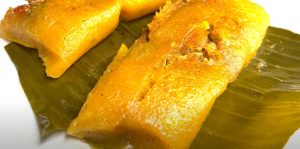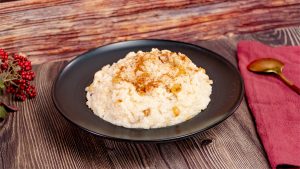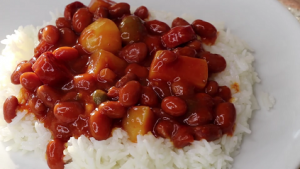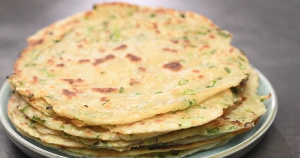Welcome to the authentic world of Puerto Rican cuisine, where we'll be exploring the delightful salmorejo - a traditional stewed crab and tomato dish. This recipe is a culinary journey that brings together succulent crab meat with a rich sauce of tomatoes, peppers, and a blend of unique seasonings, served over either steaming white rice or crunchy plantain chips.
Recaito and sazón con culantro y achiote are the two ingredients in this recipe that might not be commonly found in your home. Recaito is a cooking base that forms the foundation of many Puerto Rican dishes, made from a blend of cilantro, garlic, and onions. Sazón con culantro y achiote is a type of seasoning that adds color and flavor, usually found in the international aisle of supermarkets or in Latin grocery stores.
Key Ingredients for Puerto Rican Salmorejo: Stewed Crab and Tomatoes Recipe
Extra-virgin olive oil: This oil brings a rich and fruity flavor to the dish. Sweet peppers: They add a mild, sweet flavor to the dish. Green bell pepper: It adds a slight bitterness and crunchiness. White onion: It brings a slightly sweet and tangy flavor. Garlic: It gives the dish a pungent and spicy flavor. Roma tomatoes: They are meaty and less acidic, making the dish flavorful. Tomato sauce: It adds thickness to the dish. Recaito: A blend of aromatic ingredients, enhancing the dish's flavor. Sazón con culantro y achiote seasoning: It gives the dish a unique and robust flavor. Oregano: An herb that adds a slightly bitter and pungent flavor. Kosher salt: Salt enhances the flavors of the dish. Black pepper: It brings a bit of heat to the dish. Bay leaf: It gives the dish a subtle, floral flavor. Manzanilla olives: They add a salty and slightly sweet flavor. Capers: Small flower buds that add a tangy and salty flavor. Crabmeat: The star of the dish, bringing a sweet and succulent flavor. Water: It helps incorporate all the flavors together. White rice: It is soft and fluffy, perfect for soaking up the delicious sauce. Green plantain chips: They add a crunchy texture to the dish.
One reader, Evaleen Oneal says:





This Puerto Rican salmorejo recipe is a game-changer! The blend of crab and tomatoes creates a rich, flavorful stew that's simply irresistible. The spices and seasonings are spot on, and when served over fluffy white rice, it's a true taste of the Caribbean. I can't wait to make it again!
Mastering the Techniques for Puerto Rican Salmorejo
How to sauté the vegetables: Heat the oil in a large skillet over medium-high heat until the surface begins to ripple. Add the sweet peppers, bell pepper, onion, and garlic to the pan and sauté for 3 minutes until glossy and translucent.
How to simmer the salmorejo: Bring the ingredients to a gentle simmer, then lower the heat to maintain the simmer. Simmer uncovered for 5 minutes before adding the crabmeat and water to the pan.
How to fold in the crabmeat: Gently fold the crabmeat into the tomato sauce, avoiding stirring too aggressively to keep the crabmeat in lumps. Reduce the heat to medium-low, cover the pan, and allow the salmorejo to simmer for 10 minutes without stirring.
How To Make Puerto Rican Salmorejo
This Puerto Rican Salmorejo or Stewed Crab and Tomatoes is a complete medley of savory and hearty, made with flavorful spiced stewed crab served over rice.
Serves:
Ingredients
- 1tbspextra-virgin olive oil
- 6mini sweet peppers,(about ¼ cup) or yellow, red, or orange bell pepper, diced
- ½green bell pepper,(about ½ cup) diced
- 1medium white onion,(about 1 cup) diced
- 3clovesgarlic,minced
- 3large roma tomatoes,(about 2 cups) diced
- 8oztomato sauce,(1 can – about ¼ cup)
- 2tbsprecaito,store bought, or homemade
- 1½tspsazón con culantro y achiote seasoning,store bought or homemade
- 1tsporegano,dried
- 1tspkosher salt
- ¼tspblack pepper
- 1bay leaf
- 6manzanilla olives,stuffed
- 1tbspcapers,drained of brine
- 1lbcrabmeat,lump, backfin, or claw, or a combination of these
- ½cupwater
- white rice,cooked, to serve
- green plantain chips,fried, to serve, optional
Instructions
-
In a large skillet with a lid, heat the oil over medium-high heat until the surface of the oil begins to ripple.
-
Add the sweet peppers, bell pepper, onion, and garlic to the pan and sauté for 3 minutes, or until the vegetables look glossy and translucent.
-
Reduce the heat to medium, and add the tomatoes to the pan.
-
Cook the mixture, stirring frequently, for 4 more minutes.
-
Stir in the tomato sauce, recao, sazón, oregano, salt, pepper, bay leaf, olives, and capers.
-
Bring the ingredients to a gentle simmer and then lower the heat to maintain the simmer—tiny bubbles should just barely break the surface of the liquid.
-
Simmer uncovered for 5 minutes.
-
Add the crabmeat and water to the pan, and gently fold the meat into the tomato sauce. Avoid stirring too aggressively to keep the crabmeat in lumps.
-
Reduce the heat to medium-low, and cover the pan. Allow the salmorejo to simmer for 10 minutes without stirring.
-
Serve the salmorejo over steamed white rice, or atop fried plantain chips.
Recipe Notes
- Leftovers will keep in the refrigerator for up to 2 days and reheat well over the stovetop or in the microwave.
- The salmorejo can also be frozen for up to 2 months in a zip-top storage bag. Thaw overnight in the fridge, and warm it on the stove in a saucepan until it’s bubbling.
Nutrition
- Calories: 153.53kcal
- Fat: 3.87g
- Saturated Fat: 0.61g
- Trans Fat: 0.01g
- Monounsaturated Fat: 2.09g
- Polyunsaturated Fat: 0.66g
- Carbohydrates: 14.03g
- Fiber: 4.34g
- Sugar: 8.42g
- Protein: 16.00g
- Cholesterol: 73.33mg
- Sodium: 761.75mg
- Calcium: 104.60mg
- Potassium: 709.28mg
- Iron: 1.75mg
- Vitamin A: 215.54µg
- Vitamin C: 172.19mg
Elevate Your Puerto Rican Salmorejo with This Technique Tip
When adding the crabmeat to the tomato sauce, it's important to fold it in gently. This helps to maintain the integrity of the crab lumps, giving your salmorejo a more satisfying texture. Over-stirring can break the crabmeat into smaller pieces and result in a less desirable consistency. Remember, patience and a gentle hand are key when working with delicate ingredients like crab.
Time-Saving Tips for Preparing Puerto Rican Salmorejo
Prep ahead: Chop and measure all ingredients in advance to streamline the cooking process.
One-pot wonder: Use a single pot for both sautéing and simmering to minimize cleanup.
Efficient multitasking: While the salmorejo simmers, prepare the rice and plantain chips to save time.
Substitute Ingredients For Puerto Rican Salmorejo (Stewed Crab and Tomatoes with Rice) Recipe
extra-virgin olive oil - Substitute with avocado oil: Avocado oil has a similar mild flavor and high smoke point, making it a suitable substitute for extra-virgin olive oil in this recipe.
mini sweet peppers - Substitute with bell peppers: Bell peppers can be used as a substitute for mini sweet peppers, providing a slightly different flavor but still adding sweetness and crunch to the dish.
green bell pepper - Substitute with red bell pepper: Red bell peppers can be used as a substitute for green bell peppers, offering a slightly sweeter flavor and vibrant color to the dish.
white onion - Substitute with yellow onion: Yellow onions can be used as a substitute for white onions, providing a similar flavor profile and texture to the dish.
roma tomatoes - Substitute with vine-ripened tomatoes: Vine-ripened tomatoes can be used as a substitute for roma tomatoes, offering a similar sweet and tangy flavor.
tomato sauce - Substitute with crushed tomatoes: Crushed tomatoes can be used as a substitute for tomato sauce, providing a thicker consistency and intense tomato flavor to the dish.
recaito - Substitute with cilantro and green pepper paste: A mixture of cilantro and green pepper paste can be used as a substitute for recaito, adding a similar fresh and herbal flavor to the dish.
sazón con culantro y achiote seasoning - Substitute with homemade sazón seasoning: A homemade sazón seasoning blend can be used as a substitute, combining ingredients like ground coriander, cumin, annatto, and other spices for a similar flavor profile.
oregano - Substitute with Italian seasoning: Italian seasoning can be used as a substitute for oregano, providing a blend of herbs like oregano, basil, thyme, and rosemary for added depth of flavor.
kosher salt - Substitute with sea salt: Sea salt can be used as a substitute for kosher salt, providing a similar level of saltiness to the dish.
black pepper - Substitute with white pepper: White pepper can be used as a substitute for black pepper, offering a milder and slightly different flavor to the dish.
manzanilla olives - Substitute with green olives: Green olives can be used as a substitute for manzanilla olives, providing a similar briny and tangy flavor to the dish.
crabmeat - Substitute with lobster meat: Lobster meat can be used as a substitute for crabmeat, offering a similar sweet and delicate seafood flavor to the dish.
water - Substitute with seafood stock: Seafood stock can be used as a substitute for water, adding depth of flavor and enhancing the seafood profile of the dish.
Presenting Puerto Rican Salmorejo: A Delightful Combination of Flavors
Elevate the plating: Carefully arrange the crab and tomato stew on the plate, ensuring that each element is visible and appealing. Use negative space to create a visually striking presentation.
Garnish with fresh herbs: Sprinkle the dish with freshly chopped cilantro or parsley to add a pop of color and a touch of freshness to the vibrant stew.
Incorporate texture: Add a crispy element to the dish, such as delicate green plantain chips, to provide a contrast in texture and elevate the overall dining experience.
Highlight the crabmeat: Place the crabmeat strategically on top of the stew, allowing it to be the focal point of the dish and showcasing its succulent and flavorful nature.
Use elegant serving vessels: Consider serving the salmorejo in elegant, shallow bowls or on decorative plates to enhance the visual appeal and sophistication of the presentation.
Balance the colors: Aim for a visually appealing balance of colors on the plate, ensuring that the vibrant reds of the stew and the green accents create an enticing visual composition.
Add a touch of acidity: Consider drizzling a small amount of high-quality balsamic reduction around the edge of the plate to add a touch of acidity and elevate the flavor profile of the dish.
Emphasize precision: Pay attention to the placement of each component, ensuring that the presentation reflects precision and attention to detail, which are essential in fine dining settings.
Essential Kitchen Tools for Making Puerto Rican Salmorejo
- Skillet: A skillet is a flat-bottomed pan used for frying, searing, and browning foods. It typically has low sides and a long handle for easy maneuvering.
- Lid: A lid is used to cover the skillet during cooking to trap heat and moisture, helping to cook the food evenly and retain flavors.
- Spatula: A spatula is a kitchen tool with a broad, flat, flexible blade used for lifting, flipping, and spreading foods such as pancakes, burgers, and stir-fries.
- Cutting board: A cutting board provides a stable surface for chopping, slicing, and preparing ingredients without damaging countertops or knives.
- Chef's knife: A chef's knife is a versatile, all-purpose knife with a broad, tapered blade that is used for slicing, dicing, and chopping a variety of ingredients.
- Wooden spoon: A wooden spoon is a cooking utensil with a long handle and a rounded, flat head, commonly used for stirring, mixing, and tasting dishes.
- Measuring spoons: Measuring spoons are used to accurately measure small amounts of ingredients such as spices, salt, and baking powder in recipes.
- Measuring cup: A measuring cup is a kitchen tool used to measure liquid or dry ingredients with precision, available in various sizes such as 1 cup, ½ cup, and ¼ cup.
- Large mixing bowl: A large mixing bowl is essential for combining and mixing ingredients for recipes such as batters, doughs, and salads.
- Whisk: A whisk is a kitchen utensil used for blending, whipping, and beating ingredients, incorporating air into mixtures for aeration and smooth textures.
- Tongs: Tongs are a versatile kitchen tool with two arms and a pivot at the top, used for gripping and lifting hot or delicate foods while cooking.
- Grater: A grater is a kitchen tool with sharp-edged perforations used to shred or grate foods such as cheese, vegetables, and citrus zest.
- Colander: A colander is a bowl-shaped kitchen utensil with perforations or small holes used for draining liquids from foods such as pasta, vegetables, and fruits.
- Rice cooker: A rice cooker is an electric appliance designed to cook rice automatically, providing convenient and consistent results.
- Plates: Plates are used for serving and presenting food, available in various sizes and designs to complement different dining occasions.
- Fork: A fork is a dining utensil with pronged tips used for picking up and eating food, particularly useful for handling pasta, salads, and meats.
- Knife: A knife is an essential kitchen tool for cutting, slicing, and preparing ingredients, available in various types such as chef's knives, paring knives, and serrated knives.
- Serving spoon: A serving spoon is a large spoon with a broad, deep bowl used for serving and portioning foods such as rice, stews, and salads.
- Platter: A platter is a large, flat serving dish used for presenting and serving main courses, appetizers, and party foods.
Storing and Freezing Puerto Rican Salmorejo for Later Enjoyment
- Allow the salmorejo to cool completely before storing or freezing.
- Transfer the cooled salmorejo to an airtight container or a freezer-safe bag.
- If using a container, make sure to leave some headspace at the top to allow for expansion during freezing.
- Label the container or bag with the date and contents.
- To store in the refrigerator:
- Place the container or bag in the refrigerator.
- The salmorejo will keep well for up to 3-4 days in the refrigerator.
- To freeze:
- Place the container or bag in the freezer.
- The salmorejo can be frozen for up to 2-3 months.
- When ready to eat, thaw the frozen salmorejo in the refrigerator overnight.
- Reheat the thawed salmorejo in a saucepan over medium heat, stirring occasionally, until heated through.
- If the salmorejo appears too thick after thawing, you can add a little water or chicken broth to thin it out to your desired consistency.
- Serve the reheated salmorejo over freshly cooked white rice or plantain chips, as desired.
How To Reheat Leftover Puerto Rican Salmorejo
Reheat the salmorejo in a saucepan over medium-low heat, stirring occasionally, until it reaches the desired temperature. This method ensures that the flavors meld together and the sauce thickens slightly, making it even more delicious than when it was first cooked.
If you're short on time, you can reheat the salmorejo in the microwave. Place the desired portion in a microwave-safe bowl, cover it with a damp paper towel, and heat it in 30-second intervals, stirring between each interval, until it's heated through. Be careful not to overheat, as this can cause the crabmeat to become tough and rubbery.
For a crispy twist, reheat the salmorejo in a skillet over medium heat until it's warmed through, then serve it over freshly fried plantain chips. The contrast of the crispy chips and the rich, savory sauce is sure to impress your taste buds.
If you have leftover white rice, you can reheat it in the microwave or on the stovetop with a splash of water to help it steam and regain its fluffy texture. Serve the reheated salmorejo over the warm rice for a satisfying and comforting meal.
To give your leftover salmorejo a fresh spin, try serving it as a dip with crispy plantain chips or crusty bread. This works particularly well if you have a smaller portion of the stew left over and want to stretch it into a tasty appetizer or snack.
Fascinating Facts About Puerto Rican Salmorejo
Salmorejo is a traditional Puerto Rican dish that combines the flavors of stewed crab and tomatoes. It is a popular dish in the coastal regions of Puerto Rico, where fresh seafood is abundant. The dish is often served over steamed white rice, allowing the savory flavors to meld together. The use of recaito, sazón, and other traditional seasonings gives the dish its unique and authentic Puerto Rican flavor. Crabmeat is a key ingredient in this dish, adding a rich and indulgent taste to the stew. The combination of flavors and textures makes salmorejo a beloved dish in Puerto Rican cuisine.
Is Making Puerto Rican Salmorejo at Home Cost-Effective?
This Puerto Rican Salmorejo recipe offers a high degree of cost-effectiveness for a household. The use of affordable ingredients such as tomatoes, rice, and crabmeat makes it a budget-friendly option. The flavorful combination of sweet peppers, onions, and garlic enhances the dish without breaking the bank. The approximate cost for a household of 4 people is around $20, making it an economical choice. Overall Verdict: 9/10
Is Puerto Rican Salmorejo Healthy or Unhealthy?
The Puerto Rican salmorejo recipe, while delicious, has both healthy and unhealthy aspects. On the positive side, the dish incorporates a variety of vegetables, including sweet peppers, bell peppers, onions, garlic, and tomatoes, which provide essential vitamins, minerals, and fiber. Crabmeat is also a lean protein source, low in calories and fat, and rich in omega-3 fatty acids, which support heart health.
However, the recipe also includes some less healthy ingredients, such as:
- Sazón seasoning, which often contains MSG and high amounts of sodium
- Capers and olives, which are high in sodium
- Fried plantain chips, which are high in calories and unhealthy fats
To make this recipe healthier, consider the following suggestions:
- Use a homemade sazón seasoning blend without MSG and with less salt, or opt for a low-sodium version
- Reduce the amount of capers and olives, or rinse them before adding to the dish to remove excess sodium
- Serve the salmorejo over steamed white rice instead of fried plantain chips to reduce the calorie and fat content
- Increase the variety of vegetables in the dish, such as adding zucchini, carrots, or spinach, to boost the nutrient profile
- Use brown rice instead of white rice for added fiber and nutrients
- Incorporate other herbs and spices, like cilantro, cumin, or smoked paprika, to enhance flavor without relying on salt
Editor's Take on the Delectable Puerto Rican Salmorejo
The Puerto Rican salmorejo recipe is a delightful blend of flavors and textures. The combination of crabmeat, tomatoes, and aromatic seasonings creates a rich and savory stew that is perfect for a comforting meal. The addition of recaito and sazón adds depth and complexity to the dish, while the sweet peppers and olives provide bursts of freshness. Serving the salmorejo over steamed white rice or crispy plantain chips adds a satisfying contrast in texture. Overall, this recipe offers a taste of the vibrant and diverse flavors of Puerto Rican cuisine.
Enhance Your Puerto Rican Salmorejo (Stewed Crab and Tomatoes with Rice) Recipe with These Unique Side Dishes:
Exploring Dishes Similar to Puerto Rican Salmorejo
Appetizers and Desserts to Complement Puerto Rican Salmorejo
Why trust this Puerto Rican Salmorejo (Stewed Crab and Tomatoes with Rice) Recipe:
This recipe for Puerto Rican salmorejo features crabmeat and tomatoes stewed to perfection, creating a flavorful and aromatic dish. The combination of recaito, sazón con culantro y achiote seasoning, and manzanilla olives adds depth and richness to the dish. The use of plantain chips as a base provides a delightful crunch, complementing the savory flavors of the salmorejo. With the incorporation of traditional Puerto Rican ingredients and cooking techniques, this recipe promises an authentic and delicious dining experience.
Was this page helpful?
Have your own special recipe to share? Submit Your Recipe Today!












